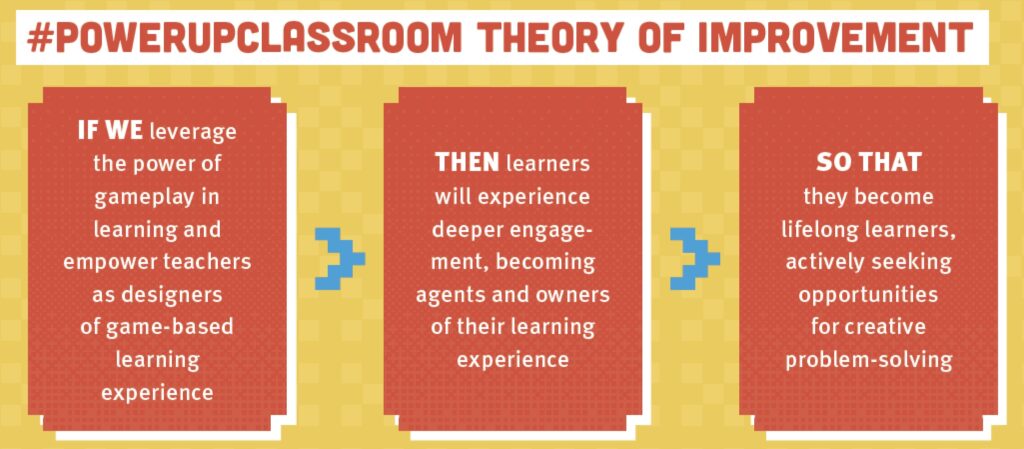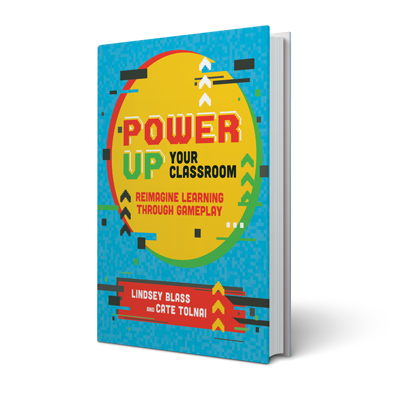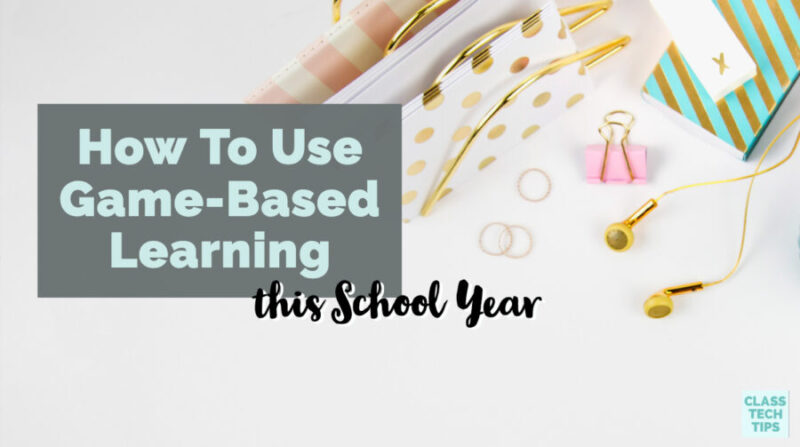If you’ve thought about using gameplay in your classroom, there is a fantastic new book on the topic! Earlier this year at the annual ISTE Conference in Philadelphia, I snagged a copy of an excellent new book. It’s titled Power Up Your Classroom: Reimagine Learning Through Gameplay. It provides actionable information for educators interested in gamification and game-based learning.
After meeting Cate Tolnai at Adobe Education’s office this summer, I knew I had to share Power Up Your Classroom on the blog. Regular readers (sign up here) know that I love spotlighting EdTech books. And this one has lots of ideas educators can take into their classroom. Co-authors Cate Tolnai and Lindsey Blass have put together an excellent resource. They were kind enough to answer some of my questions about the book below!
Grab your copy of Power Up Your Classroom on Amazon!
Gamification and Game-Based Learning
What motivated you to write a book about gamification and game-based learning?
We strongly believe that learning should be FUN. By leveraging the power of play, educators can provide learners with purpose, motivation, and increased engagement in their learning experience. So often, engagement is confused with compliance. Students simply following the prescribed flow of a lesson labels them as being “engaged.” Through game-based learning, we see students (and educators) become truly engaged. They take ownership in their learning experiences.
We had both seen the power of gameplay in action with the educators and students we partner directly with. When the opportunity presented itself to share this with a broader audience through writing a book, we jumped at it!
Game-Based Learning in Action
Why is this topic important to you?
By the time our paths crossed, we each had powerful experiences in classrooms and with professional learners that were fun, engaging, and truly different. Being connected educators, we are able to share our experiences far and wide with our professional learning networks. The more we share, the more we hear similar struggles amongst teachers and leaders. How can we design learning that really sticks for adults and that eventually make their way into classrooms?
This question was always intriguing to both of us. So we find opportunities to present separately and together on the topic often. From district trainings to conference sessions to local happy hours, we take every opportunity that comes our way to build this context for play and creativity. We are both deeply committed to demonstrating how the power of play can be leveraged to support and promote deeper engagement in teaching and learning.
Aside from the work we’ve done with our own students when we were classroom teachers and our more recent work as professional learning leaders, we have the awesome opportunity to inspire this instructional approach in classrooms across California through the Krause Center for Innovation at Foothill College.
We each design and teach this course in a unique way. But we hold true to the empowerment of educators as learners and ask our students to share evidence of Game-Based Learning in their own classrooms. The rewards are huge! We are able to impact so many learners by following our true passion. We get to witness educators discover new passions inside of themselves.
Making GBL Happen
How can educators include gameplay in their classrooms?
There are so many ways that we see gameplay included in the classrooms we visit and learn about throughout our PLN. A unique feature of our book is the collection of Game Master sections. We include it to answer this precise question. We feature real-world examples of inspiring instructional gameplay that spans subject areas, grade levels, and audiences. From professional learning digital badges (shout out to Gregg Eilers) to Minecraft EDU (shout out to Diane Main) to Jacob Aringo’s Jedi Academy, where every student has a progress bar to track their growth… each example paints a real picture of instructional gameplay that we hope our readers can connect to.
Is there one story of successful GBL you’d like to share?
Well, we both had the best time at the 2019 ISTE Conference in Philadelphia. Since we were not only debuting our book, but we had a slew of presentations, events, and appointments to promote the book. In our workshop session, we set the attendees up to be active players in several instructional games. This included a custom-designed #PowerUpClassroom Digital BreakOut EDU game.
In the middle of playing Quizlet Live, we asked the attendees to group up based on the animals that appeared on their screens. The room full of over 100 adults burst into happy chatter as they all started calling out to find their teammates. Educators who entered the room as literal strangers from across the globe were now closely collaborating to answer simple questions and race other players to the final question. There’s nothing better than building learning experiences that people connect to and value and seeing that enjoyment in action!

A Framework for GBL
In your book, you discuss a GBL framework. How can educators use this resource in their classrooms?
Our #PowerUpClassroom GBL Design Framework arms educators and students with action steps to meaningfully design instructional games. In order to create impactful learning experiences, we provide five clear areas of design.
- We ask designers to first consider objective, or instructional focus, of the game. Having clarity around your objective is essential.
- The objective then sets to the stage to identifying the delivery (game setting, tools, and action steps) and purpose (challenge) of the game.
- Determining how and when the progress of the game will be assessed is also key. We explain that games can serve as the assessment tool itself or can be designed to assess other learning. It’s important to know the role that the game will play in assessment in general so that players understand why the game matters to play.
- Finally, we remind designers to always plan for next steps and build opportunities for players to level-up their learning both during and following gameplay.
We hope that educators use this framework to build games and provide it to students who are designing games, as well. It ensures consistency in design across classrooms and schools and helps educators talk confidently about GBL.
Teacher Book Club Tips
What advice would you give a group of educators who want to hold a book club for your book?

Funny you should ask! We included a full chapter by chapter Book Study Guide in the back of the book in order to allow readers to deepen the experience through collaborative dialogue. After assembling a motivated study group, create a reading and meeting schedule that is ambitious enough to keep members engaged throughout, but also relaxed enough to allow for the busy life of an educator. Choose a facilitator to ensure equity of voices and to keep conversation student-centered and solutions oriented. You can use the guiding questions from the official book study, or generate your own questions as you read!
How can readers connect with you and learn more about your work?
Connect with us on Twitter (Lindsey and Cate) to share your experiences, ask us questions, and join a growing community of game-based learning enthusiasts! You can also follow the larger Power Up Classroom community using the hashtag #PowerUpClassroom.
Learn more about Cate and Lindsey’s work by following along with their updates on Twitter. And check out Power Up Your Classroom now available on Amazon in paperback and Kindle format.







